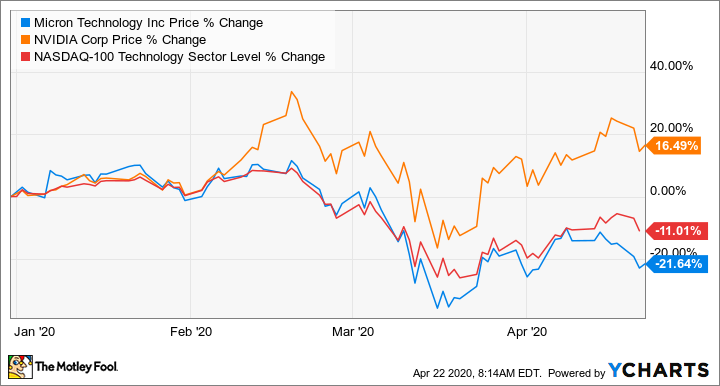NVIDIA vs. Micron Technology: Which Is the Better Coronavirus Stock? – Motley Fool
Chipmakers NVIDIA (NASDAQ:NVDA) and Micron Technology (NASDAQ:MU) have enjoyed vastly different fortunes on the stock market so far in 2020. NVIDIA stock has beaten the broader market crash thanks to a solid set of earnings results in February, its strong balance sheet, and potential tailwinds for its data center and artificial intelligence-related businesses thanks to the COVID-19 outbreak.
Micron investors haven’t been as lucky, even though the memory specialist is touted to benefit from the growing demand for data center components. Its shares have lost a quarter of their value so far in 2020. So, should investors go with the flow and bet on NVIDIA as the better pick in this novel coronavirus-rattled stock market? Let’s find out.
Don’t discount Micron Technology just yet
Micron Technology stock may have been beaten down badly this year, but the good part is that the memory market conditions seem to be turning in the company’s favor now. Dynamic random access memory (DRAM) prices rose last month thanks to strong demand and tight supplies.
A third-party report points out that contract prices of 32GB DRAM server chips increased 12% in the first quarter of the year. A similar trend was seen in the NAND flash market, where the price of 128GB chips increased 5.6% during the quarter.
This price rise is a result of an increase in demand for telecommuting, online shopping, gaming, and distance education on account of social distancing measures that have forced people to work and study from home. The higher strain on data centers has led to an increase in demand for enterprise solid-state drives (SSDs), giving Micron’s NAND business a shot in the arm.
Higher demand for memory products has led to shallow inventory levels and pushed up prices. The trend of strong memory prices is expected to continue. TrendForce predicts a 20% increase in server DRAM prices this quarter, while the price of enterprise SSDs could go up 10% to 15%. The firm was earlier anticipating a server DRAM price rise of 15%, along with a 5% to 10% increase in enterprise SSD prices this quarter.

Image source: Getty Images.
The demand-supply dynamics of the memory market could favor Micron in the coming months. Investors, however, shouldn’t ignore the possibility of a prolonged downturn induced by the novel coronavirus. In that case, it is feared that memory demand could start falling and negatively affect the price growth momentum.
TrendForce anticipates that the average selling prices of memory products might jump by a smaller degree than what it was predicting earlier if demand weakens in the coming quarters. But the good part is that the memory market’s revenue was down 32.7% in 2019 because of oversupply, according to Gartner‘s estimates. This year, the firm forecasts that the memory market’s revenue could grow by 13.9%.
As such, the favorable demand-supply balance could turn out to be a tailwind for Micron Technology and help the stock regain its momentum.
NVIDIA may be walking a tightrope
NVIDIA enjoys tailwinds similar to Micron in the data center business that supplies 31% of the company’s total business. The stock was recently upgraded by Needham analyst Rajvindra Gill, who believes that demand for NVIDIA’s graphics card could increase in the medical field in the wake of the COVID-19 pandemic.
According to Gill, NVIDIA’s GPUs (graphics processing units) can help fight the novel coronavirus pandemic as they can remarkably speed up genome analysis and identify potential treatments. Gill also adds that demand for artificial intelligence (AI) applications could get a shot in the arm and boost NVIDIA’s GPU demand.
But at the same time, there is a chance of NVIDIA’s gaming business running into choppy waters because of the novel coronavirus. Reports suggest that sales of gaming GPUs have tanked of late, which may have forced NVIDIA to delay the reveal of new graphics cards at the GPU Technology Conference in March.
That could spell trouble for NVIDIA in the coming quarters, as gaming is its largest business segment by revenue, accounting for 48% of the top line. The gaming business should have ideally prospered as lockdowns across the globe have led to an increase in gaming activity. However, that may not necessarily translate into an increase in graphics card demand.
The true picture will come to light only next month when NVIDIA releases its next set of results. But the good part is that the chipmaker looks well-equipped to weather the downturn because of a solid balance sheet — NVIDIA has nearly $11 billion in cash as compared to $2.6 billion in debt.
So, the novel coronavirus may cause short-term headwinds for NVIDIA in case its gaming business takes a hit, and the stock might pull back as a result.
The verdict
It is difficult to predict a clear winner between the two stocks in light of the uncertainty that the COVID-19 outbreak has caused. But the valuation indicates that Micron might be the safer bet of the two companies.
Micron’s trailing price-to-earnings (P/E) ratio of 21 is much lower than NVIDIA’s multiple of 63. NVIDIA stock seems richly valued right now considering that its five-year average P/E ratio stands at 39. Micron also seems overvalued to an extent, as its five-year average earnings multiple is 21.
However, NVIDIA shares have rallied remarkably this year, as investors have been anticipating that the tech giant will prosper despite the COVID-19 outbreak. Any weakness in NVIDIA’s upcoming results might force investors into pressing the panic button and affect profits. Micron, on the other hand, could surprise Wall Street if memory prices continue to improve.







